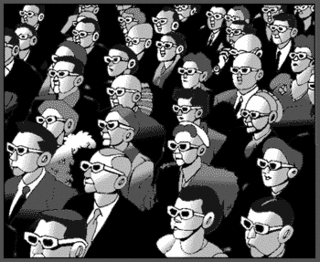The Death of Cinema: DVDs
 Did you know that right now in Houston, McDonalds is testing its RedBox, a coke-machine like way of renting movies after finishing your Big Mac?
Did you know that right now in Houston, McDonalds is testing its RedBox, a coke-machine like way of renting movies after finishing your Big Mac?Well, put another one on the board for the mushrooming DVD market.
These days, the DVD is the most fashionable medium for cinematic content.
As both the New Yorker and Investor's Business Daily pointed out earlier this week, blockbusters are bombing left and right, week after week.
It's strange to think how DVD sales have cannibalized the traditional movie theatre experience, bringing in receipts 2X the box office's.
The traditional Hollywood formula of creating high-risk, over-budgeted films is simply no longer viable in a globe overtaken by DVD revenues.
Box office sales have come to a screeching halt for several reasons.
The ubiquity of home theatres.
But it still doesn't lead us to the pot of gold answer on why DVDs reign supreme.
We know DVDs can't compete on price, since they cost twice what you pay to sit inside a theatre and make as much as a mess as you want.
It's not piracy, either.
What about convenience?
Not really.
Consumers still have to trek out to retailers like Walmart to buy DVDs, not to mention wait up to 6 months before a release date (I should know; I waited 2 years for Scorcese's "Casino" to hit the shelves).
Nope, the real reason DVDs are squandering movie theatre revenues is because of something we at Catablast! Media have talking about for months.
Long tail.
Long tail is the term Wired Magazine's Chris Anderson coined in 2004 to describe the economic model best suited for our times.
Because today, it's not about the hits --it's about the misses.
Long tail basically says that products that are in low demand or have low sales volume can "collectively make up a market share that rivals or even exceeds the relatively few current bestsellers and blockbusters, if the store or distribution channel is large enough."
The long tail equation spells that the total volume of low popularity items is greater the volume of high popularity items.
When you take a hard look at what people but at Amazon or rent at Netflix, the Long Tail theory makes perfect sense.
Today's consumer clicks his or her way to exactly what it is they want, whether it's downloading eccentric MP3s or bidding several hundred dollars on a pez dispenser.
In a time of declining mainstream output, where fragmented media -- like blogs and podcasts - are more rich in content than their consolidated, bloated counterparts, long tail captures the increasing evanescence of mass customization.
Long Tail is also useful for understanding the relationship between sales distributions and storage costs.
Look at it this way.
If the cost of storage is too high, long tail is absent.
Brick and mortar shops, who have much less shelf space to allocate than their wired up, online storfront rivals (most of which follow a hub-and-spoke distribution system) cannot afford to hold assets that they may or may not sell.
On the other hand, because of low opportunity costs, the online business has the luxury of catering to minority tastes and shelving whatever they damn please.
eBay and Google, which show us that micro-markets can be profitable, are other businesses thriving off of long tail.
eBay and Google are built to please both mainstreamer and specializer alike.
In fact, long tail is what we at Catablast! Media are trying to exploit, covering business topics you won't see at Yahoo Finance or CNN Money, for example.
Longtail, which screams "One size does NOT fit all," kills categories.
To return back home after a long digression: Long tail is what's killing the box office and juicing up the $15 billion dollar a year DVD market.
While DVD sales of movies that did well at the Box office are falling, smaller movies are filling the gap. The New Yorker believes that
the new DVD audience is so diverse that companies can target niche markets and still sell millions of disks. Because specialized markets are more predictable, the risk of failure is much lower, and so small-to-mid-budget movies can be very profitable indeed.As far as the companies who produce DVDs, the economics are on their side.
Unlike the now obsolete videotape, the DVD is an incredibly high margin business --cheap to make and high in demand.
So while Hollywood icon Jack Valenti can pronounce that offering consumers "an epic viewing experience and alluring social adventure " is something that cannot be duplicated at home, it won't be until Hollywood learns how to micromarket that we'll see any sort of mass pilgrimage back to the theatres.
<< Home